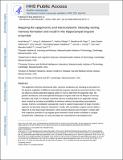| dc.contributor.author | Marco, Asaf | |
| dc.contributor.author | Meharena, Hiruy S. | |
| dc.contributor.author | Dileep, Vishnu | |
| dc.contributor.author | Raju, Ravikiran M. | |
| dc.contributor.author | Davila Velderrain, Jose | |
| dc.contributor.author | Zhang, Amy Letao | |
| dc.contributor.author | Adaikkan, Chinnakkaruppan | |
| dc.contributor.author | Young, Jennie Zin-Ney | |
| dc.contributor.author | Gao, Fan | |
| dc.contributor.author | Kellis, Manolis | |
| dc.contributor.author | Tsai, Li-Huei | |
| dc.date.accessioned | 2021-04-12T16:00:55Z | |
| dc.date.available | 2021-04-12T16:00:55Z | |
| dc.date.issued | 2020-10 | |
| dc.date.submitted | 2020-01 | |
| dc.identifier.issn | 1097-6256 | |
| dc.identifier.issn | 1546-1726 | |
| dc.identifier.uri | https://hdl.handle.net/1721.1/130450 | |
| dc.description.abstract | The epigenome and three-dimensional (3D) genomic architecture are emerging as key factors in the dynamic regulation of different transcriptional programs required for neuronal functions. In this study, we used an activity-dependent tagging system in mice to determine the epigenetic state, 3D genome architecture and transcriptional landscape of engram cells over the lifespan of memory formation and recall. Our findings reveal that memory encoding leads to an epigenetic priming event, marked by increased accessibility of enhancers without the corresponding transcriptional changes. Memory consolidation subsequently results in spatial reorganization of large chromatin segments and promoter–enhancer interactions. Finally, with reactivation, engram neurons use a subset of de novo long-range interactions, where primed enhancers are brought in contact with their respective promoters to upregulate genes involved in local protein translation in synaptic compartments. Collectively, our work elucidates the comprehensive transcriptional and epigenomic landscape across the lifespan of memory formation and recall in the hippocampal engram ensemble. | en_US |
| dc.description.sponsorship | National Institutes of Health (Grants RF1AG062377, AF1AG054012, RO1NS102730, RF1AG064321, R01AG058002, U01NS110453, R01AG062335, UG3NS115064, R01AG067151, R01MH109978, U01MH119509, R01HG008155, U24HG009446, 5T32HD09806) | en_US |
| dc.language.iso | en | |
| dc.publisher | Springer Science and Business Media LLC | en_US |
| dc.relation.isversionof | http://dx.doi.org/10.1038/s41593-020-00717-0 | en_US |
| dc.rights | Article is made available in accordance with the publisher's policy and may be subject to US copyright law. Please refer to the publisher's site for terms of use. | en_US |
| dc.source | PMC | en_US |
| dc.title | Mapping the epigenomic and transcriptomic interplay during memory formation and recall in the hippocampal engram ensemble | en_US |
| dc.type | Article | en_US |
| dc.identifier.citation | Marco, Asaf et al. "Mapping the epigenomic and transcriptomic interplay during memory formation and recall in the hippocampal engram ensemble." Nature Neuroscience 23, 12 (October 2020): 1606–1617. © 2020 The Author(s) | en_US |
| dc.contributor.department | Picower Institute for Learning and Memory | en_US |
| dc.contributor.department | Massachusetts Institute of Technology. Department of Brain and Cognitive Sciences | en_US |
| dc.contributor.department | Massachusetts Institute of Technology. Computer Science and Artificial Intelligence Laboratory | en_US |
| dc.relation.journal | Nature Neuroscience | en_US |
| dc.eprint.version | Author's final manuscript | en_US |
| dc.type.uri | http://purl.org/eprint/type/JournalArticle | en_US |
| eprint.status | http://purl.org/eprint/status/PeerReviewed | en_US |
| dc.date.updated | 2021-04-06T15:30:40Z | |
| dspace.orderedauthors | Marco, A; Meharena, HS; Dileep, V; Raju, RM; Davila-Velderrain, J; Zhang, AL; Adaikkan, C; Young, JZ; Gao, F; Kellis, M; Tsai, L-H | en_US |
| dspace.date.submission | 2021-04-06T15:30:43Z | |
| mit.journal.volume | 23 | en_US |
| mit.journal.issue | 12 | en_US |
| mit.license | PUBLISHER_POLICY | |
| mit.metadata.status | Authority Work and Publication Information Needed | |
